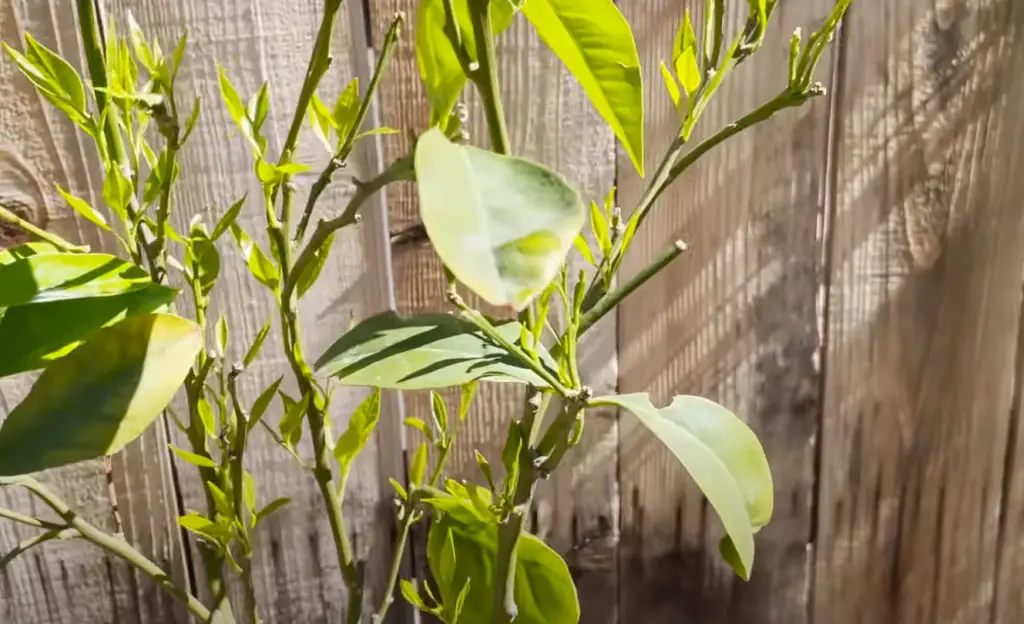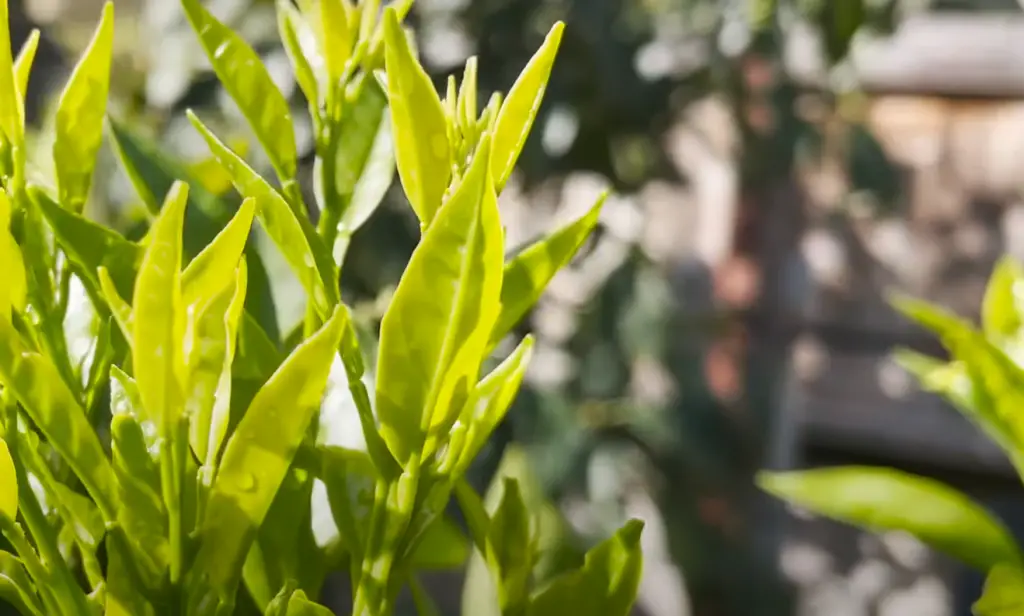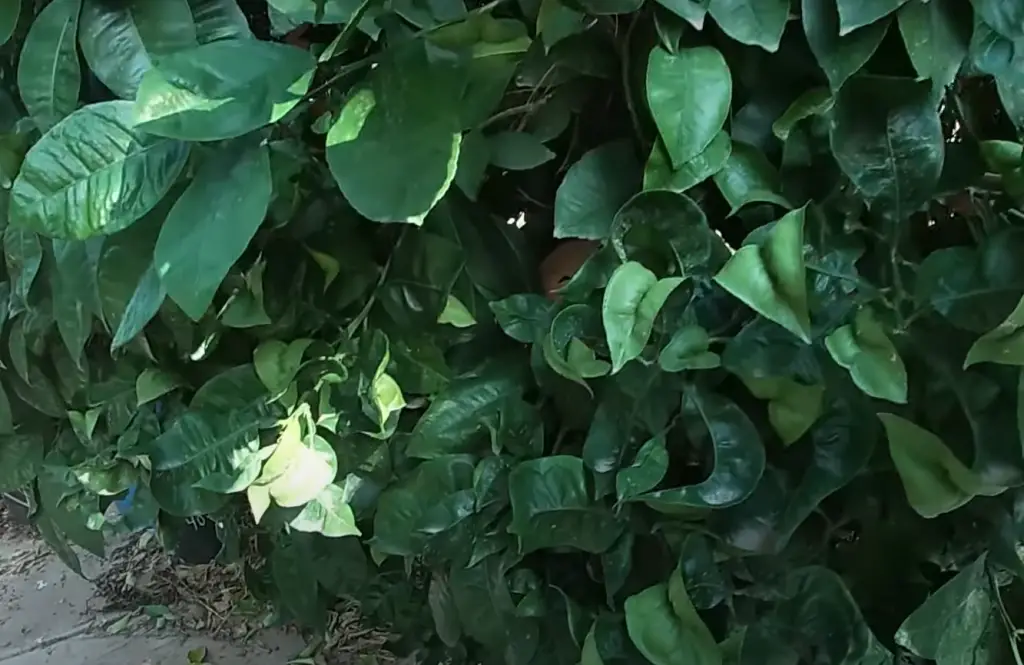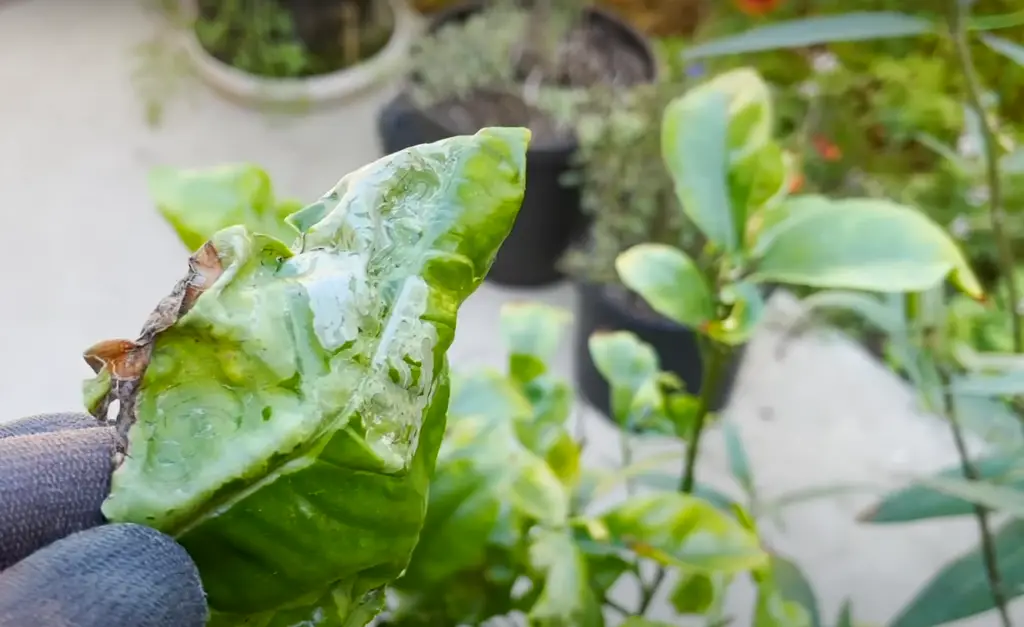Are you concerned that your lemon tree’s leaves are curling? Seeing funny shapes on the leaves of citrus trees is certainly alarming, but fear not – this article will tackle all of your questions pertaining to why your lemon tree’s leaves may be taking an unusual shape. We understand that it can be bewildering to witness a citrus plant’s leaves begin to twist and curl away from their natural state, so read on as we provide some insight into what could be causing this disconcerting problem. From environmental concerns to changes in care or lack thereof, we’ll approach each issue with useful tips and advice for getting those lusciously fragrant lemons back in full swing!
Common Causes of Lemon Tree Leaves Curling
Environmental Stress
The most frequent reason for lemon tree leaves to curl is environmental stress.

Non-optimal weather conditions such as too much or too little water, extreme temperatures, and strong winds can all make the leaves of a lemon tree start to curl.
Disease or Pest Infestation
Diseases and pest infestations can also cause leaves to curl up. Lemon tree leaves may curl due to various diseases such as powdery mildew, sooty mold, citrus blight, and Alternaria brown spot.[1]
Improper Care
If the lemon tree is not receiving proper care, it can lead to its leaves curling. Poor soil conditions, such as having too much clay or poor drainage, can result in a lack of nutrients and water for the tree which may cause leaf curl. Other signs of improper care include yellowing or brown spots on the leaves.
Knowing the cause of curled lemon tree leaves can assist in finding the solution and maintaining your lemon tree’s health and fruit production. If any of these issues are causing your lemon tree’s leaves to curl up, take action quickly so you can save your lemon crop and get back on track for successful harvests!
How to Treat Lemon Tree Leaves Curling
Check for Pests and Diseases
One of the initial steps to take if the leaves of your lemon tree are curling is to inspect for pests or diseases. Insects such as aphids and spider mites can cause leaf curl, as can fungal infections like alternaria blight. By examining the affected leaves closely and looking for signs of insects or fungi, you can determine whether the problem is due to a pest or disease.
Monitor Water Intake
Lemon trees need regular watering, especially during dry spells. If the soil around your lemon tree is becoming too dry and hard to penetrate, then you may be underwatering it. Keep an eye on your lemon tree’s water intake so that its roots don’t become too dry and cause leaf curling. Take note of how frequently you need to water the tree by observing how quickly the soil around the tree dries up after a rain or watering session. Generally, young lemon trees should receive about 1 inch of water per week, while mature trees should get closer to 2 inches per week depending on climate conditions. Water in the morning so that any excess moisture can evaporate throughout the day and prevent fungal diseases from taking root at night time.

Additionally, opt for drip irrigation to help deliver the water directly to the tree’s roots and avoid any runoff or pooling of water around the trunk.
Increase Sunlight Exposure
Lemon trees need lots of sunlight to thrive, so make sure your tree is getting enough direct sunlight each day.
If the leaves are curling due to a lack of sufficient light, then try relocating the tree to an area with more direct exposure or supplement natural sunlight with artificial lighting. This will help ensure that photosynthesis is occurring properly and that all of the necessary nutrients are being absorbed by the plant’s roots. Additionally, consider using reflective materials such as white plastic mulch around the base of your lemon tree to help reflect additional sunlight onto its leaves for added growth and health benefits. [2]Prune Away Damaged Branches
When lemon tree leaves start to curl, pruning away any branches that are weak or damaged can help the tree stay healthy and balanced. This will encourage new growth and ensure that your tree is getting enough essential nutrients for optimal leaf health. Additionally, make sure to remove any dead or diseased branches as soon as possible to prevent them from spreading diseases to other parts of the tree. Prune away branches in early spring before new growth begins so that you don’t risk stunting its development with too much pruning at once. If possible, consult an arborist about proper pruning techniques so that you don’t accidentally damage healthy portions of your lemon tree in the process.
Does Lemon Tree Leaf Curling Happen With Indoor Lemon Trees?
Yes, lemon tree leaf curling can happen with indoor lemon trees. Although the cause of the issue may be different for indoor plants than outdoor plants, it is typically caused by a lack of humidity and dry air. If your indoor lemon tree is suffering from leaf curling, you should increase the amount of humidity around the plant to help it recover. This can be done by misting the leaves with water once or twice each day, or placing a humidifier in the same room as your plant. Additionally, try to keep your indoor temperature more consistent and avoid extreme temperature fluctuations that could stress out your lemon tree and lead to leaf curling.

Finally, make sure your plant is receiving enough light – ideally 12 hours of bright (indirect) sunlight each day. If your lemon tree is in a spot that doesn’t get enough light, you may need to move it to a sunnier location. You can also give your plant some extra energy by supplementing with grow lights for 12 hours of additional indirect sunlight each day. If these steps don’t help the leaf curling issue improve, it may be worth seeking advice from an expert or trying some existing natural remedies for treating lemon tree leaf curling.
How Long Does It Take To Grow A Lemon?
Lemon trees can take anywhere from three to five years to reach full maturity and start producing fruit. During this time, the tree will be growing in size and should be regularly pruned and cared for to ensure it is healthy and receiving enough sunlight, water, and nutrients. Different varieties of lemon trees may have slightly different growth rates, but generally speaking you can expect your lemon tree to start bearing fruit within a few years of planting.
Once mature, lemon trees are prolific producers of lemons and can yield several hundred fruits per year depending on conditions. While the season for harvesting lemons can vary by region and climate zone, most lemons will ripen during late spring or early summer with some types maturing at different times of the year.
Where Do Lemon Plants Grow Best?
Lemon trees thrive in areas where they can get plenty of sunlight and are protected from strong winds.
Soil should be light and sandy with good drainage. If you live in an area that doesn’t naturally provide these conditions, it is possible to grow a lemon tree indoors or outdoors by creating an artificial environment with the right type of soil, fertilizer, irrigation system, light source (such as a greenhouse), and temperature control. Properly cared for lemon plants will reward you with beautiful foliage and delicious lemons! [3]Once your lemon plant has been planted in the correct environment for growth, it’s important to monitor its health and look out for any signs of stress. One of the most common problems faced by lemon plants is leaf curling or yellowing. While this could be caused by a number of things, such as disease or pest infestation, one possible cause is environmental stress due to incorrect watering practices or temperature fluctuations.
Correcting an improper watering schedule is the first step in treating leaf curl on your lemon tree. If you are overwatering your plant, cut back to only giving water when the top inch of soil feels dry to the touch. On the other hand, if you are under-watering your plant, increase how often you water it until its leaves start to perk up.
What Are The Stages Of A Lemon Tree?
Lemon trees go through several distinct stages during their life cycle.
- Seedling stage: This is the earliest stage of a lemon tree’s life, when it first begins to sprout and grow from a seed. At this point, it is very small and fragile.
- Sapling stage: During this period, the young tree grows in size but still has a shallow root system. It needs careful watering during this time to ensure that it establishes strong roots before entering its next phase of growth.
- Juvenile stage: The juvenile stage marks the beginning of rapid growth for your lemon tree as it continues to mature. During this phase, leaves will become larger and foliage may begin to thicken as well.
- Maturity stage: This is the point where your lemon tree is considered fully mature and ready to produce fruit. Depending on the variety, this can take anywhere from three to five years after planting a seed or sapling. At this time, you may begin to notice changes in leaf shape and size as well as flower production.
Once your lemon tree has reached maturity, it should require only minimal maintenance such as occasional pruning and fertilizing in order to stay healthy and productive for many years.

If you notice that the leaves of your lemon tree are curling, however, it could indicate an underlying problem that needs addressing.
Are Lemons Green Before They Turn Yellow?
The answer is, usually not. Lemons start green and stay that way until they are fully ripe. The yellow color indicates the lemon has reached its peak level of sweetness and is ready to be eaten or used in recipes. However, some lemons may show a slight yellowing before they become completely ripe. This happens when the fruit’s sugar content begins to rise faster than the acid content can keep up with. As such, you may see faint hints of yellow even on immature lemons. [4]
Do Lemons Need Sun To Ripe?
Lemons do need sun to ripen, but they can also be harvested while still green. Lemons that are kept on the tree and allowed to mature naturally will turn from green to yellow as they stay in the warmth and sunshine. However, depending on where you live, it might be necessary to bring lemons inside in order to get them to fully ripen.
It’s important not to leave unripe lemons on the tree for too long, as this could cause them to become overripe. If you have to bring lemons inside, it’s best to wait until they are slightly yellow and then keep them in a cool, dry place. You can also put them in paper bags or wrap them in newspaper to help ripen them quicker. Remember that lemon tree leaves may start curling if the lemons are kept on the tree for too long – so don’t forget to take action before it’s too late!

Once your lemons have ripened, you can enjoy their sweet flavor in a variety of ways. From fresh squeezed juice, to baked goods and marinades – there is no shortage of tasty recipes that incorporate this tart citrus fruit. Lemons are also known for their health benefits, as they are rich in Vitamin C and other antioxidants. So don’t delay – get your lemons off the tree before they start to curl and enjoy their deliciousness today! [6]
FAQ
How do you fix curled leaves on a lemon tree?
The best way to fix curled leaves on a lemon tree is to first identify the cause. Common causes of leaf curling include pest infestation, nutrient deficiency, over- or under-watering, and environmental stress. If pests are the culprit, treating the affected area with an insecticidal soap or horticultural oil can help control the problem. For cases of nutrient deficiencies or excesses, applying a balanced fertilizer should correct the condition. Finally, if environmental conditions are too extreme (too hot/cold), try moving your lemon tree to a more suitable location.
Can too much water cause lemon tree leaves to curl?
Yes, too much water can cause lemon tree leaves to curl. If you’re overwatering your lemon tree, the leaves may turn yellow and start to curl. To solve this problem, make sure you are watering your lemon tree only when the soil feels dry to the touch.
What is the best fertilizer for a lemon tree?
The best fertilizer for a lemon tree is one that contains nitrogen, phosphorus, potassium, magnesium and other essential micronutrients such as zinc or iron. A balanced fertilizer with these nutrients in equal parts is ideal. Always follow all instructions on the packaging carefully and apply according to directions. Over-fertilizing can cause leaf curling and other problems, so use caution when applying fertilizers to your lemon tree.
Can too much sun cause a lemon tree’s leaves to curl?
Yes, too much sun can cause a lemon tree’s leaves to curl. To prevent this from happening, make sure to provide your lemon tree with plenty of shade during the hottest parts of the day in summertime. If possible, place the tree near a shaded wall or fence to protect it from the sun’s rays.
Can pruning help with curled leaves on a lemon tree?
Yes, pruning can help reduce leaf curling on a lemon tree by encouraging air circulation and helping the plant manage its growth better. Try cutting off any dead branches or leaves that may be causing an obstruction and preventing light and air from reaching the other buds and shoots. Prune lightly so as not to overstress your plant.
Will lemon tree leaves uncurl?
Unfortunately, the answer is mostly no. Once the leaves of a lemon tree have curled due to disease, insect infestation or other environmental issues, they are unlikely to uncurl again. Therefore, it’s important to take action quickly if you want to save your lemon tree. First and foremost, examine the tree for signs of pests or disease.

If any issues are present, treat them according to recommended instructions. In addition to pest control and treatment of diseases, ensure that your lemon tree has adequate water and fertilizer so it can remain healthy and strong in spite of its leaf curling problem. Prune away affected branches as necessary and apply an appropriate insecticide when needed. If environmental conditions such as too much sun or wind are causing the leaves to curl, try to provide the tree with more shade and protection from wind. Finally, make sure that you are not over-watering your lemon tree as too much water can lead to leaf curling in some cases. With a little TLC, your lemon tree should be able to recover from its leaf curling issues and thrive again.
What are the symptoms of nitrogen deficiency in lemon?
Yellowing of the leaves is one of the most common symptoms of nitrogen deficiency in lemon. This yellowing typically starts at the tips and edges, or along the veins of the leaves, before spreading outwards. In extreme cases, entire leaves may turn yellow. The leaf curl will also be more pronounced as a result of this deficiency. Other signs include stunted growth and poor flowering and fruit production.
What are the signs of magnesium deficiency in lemon trees?
One of the clearest signs of magnesium deficiency in lemon trees is yellowing or curling leaves. The veins on the leaves may also appear to be darker than normal, and the new growth can become stunted and fail to develop fully. Leaves may also have spots or patches that are a lighter shade of green than the rest of the leaf. If there is not enough magnesium in the soil, then it will be difficult for your lemon tree to photosynthesize efficiently and create enough energy for proper growth. Another sign that your lemon tree might have a magnesium deficiency is if you notice smaller or fewer fruits than usual forming on its branches. This is because magnesium helps move sugars from leaves into fruits, so when there isn’t enough present, the fruit cannot develop properly.
Useful Video: 2 Reasons Why Your Citrus Leaves Are Curling | Leaf Curl
Conclusion
In conclusion, lemon tree leaves curling is a common problem that can have many causes. Identifying the source of the problem and taking appropriate action quickly is key to preventing further stress to your plant. Regular pruning, cleaning, and monitoring are all essential steps in keeping your lemon tree healthy and happy. If you think your tree may be affected by pests or disease, contact your local extension office for help identifying the issue and determining the best course of treatment. With some dedication and time, you can restore balance to your lemon tree’s environment so it can thrive! Thank you for reading!
References:
- https://www.gardenerbasics.com/blog/lemon-tree-leaves-curling
- https://www.gardeningknowhow.com/edible/fruits/citrus/curling-citrus-leaves.htm
- https://www.thespruce.com/why-lemon-tree-leaves-are-curling-7497105
- https://www.gardenerreport.com/lemon-tree-leaves-curling/
- https://tuigarden.co.nz/garden-questions/why-are-my-lemon-tree-leaves-curling/
- https://deepgreenpermaculture.com/2021/01/30/citrus-problems-leaves-curling-inwards-along-their-length/










Leave a Reply
View Comments